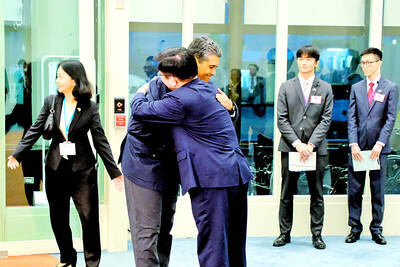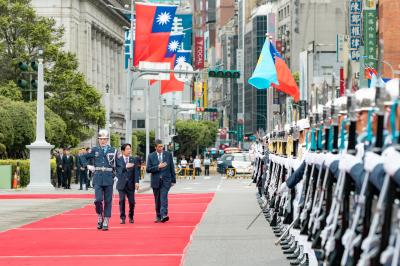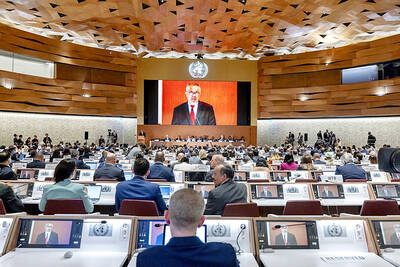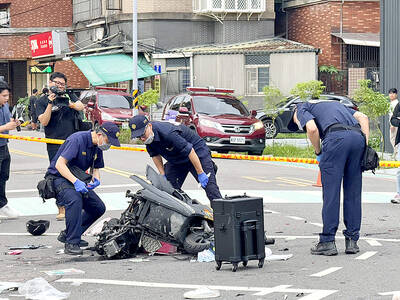Academia Sinica President Wong Chi-huey (翁啟惠) yesterday urged the government to push development of renewable energy sources to ensure national security.
Ahead of the National Energy Conference that opens in Taipei today, Wong said the government should establish award mechanisms to boost the proportion of renewable energy use to 15 percent.
Taiwan possesses advanced wind and solar power generation technologies, and is blessed with abundant geothermal power, which give it a competitive edge in developing alternative energy sources, Wong said.
Nuclear energy is cheap, since waste disposal is costly and the production process poses a threat to public safety, he said.
Wong said that Taiwan’s annual carbon dioxide emissions are about 11 tonnes per capita, nearly three times the global average. The only way to lower carbon emissions and reduce dependency on imported energy is to formulate energy conservation and carbon reduction policies, and develop renewable energy sources, he said.
Citing Ministry of Science and Technology statistics, Wang said that while the proportion of electricity supplies produced by alternative sources in China and Japan has surpassed 10 percent, Taiwan’s supply remained at 2.5 percent from 2006 through 2013.
“The government should actively provide incentives to industries with low energy consumption to drive the development of renewable energy technology, rather than waiting for the price of alternative energies to fall,” he said.
The ministry’s National Energy Program sets the generation capacity from renewable energy sources at 12 percent of the nation’s overall energy supply — or 6.5 million kilowatt-hours — but so far only 4 percent has been achieved, he said.
Program leader Lee Chih-kung (李世光) said that hydraulic energy is the most effective of Taiwan’s renewable energy sources, but it is unlikely that more dams will be built because the nation does not have enough water resources.
If Taiwan can develop geothermal energy from 2,500m to 3,000m below ground level, it will be able to boost its energy supply from renewable sources to about 7 percent, Lee said.
Taiwan Environmental Protection Union Secretary-General Chen Bing-heng (陳秉亨) said conservation should precede the development of “green” energy sources.
Data shows that energy consumption is concentrated in four areas: electricity consumption, industrial energy use, transportation and construction, Chen said.
“By reducing the amount of energy consumed in these four areas, Taiwan will be able reduce its energy use by 39 percent,” he said.
Green Citizen’s Action Alliance deputy secretary-general Hung Shen-han (洪申翰) said energy conservation is the best option for ensuring low carbon emissions and ample energy supply.

Palauan President Surangel Whipps Jr arrived in Taiwan last night to kick off his first visit to the country since beginning his second term earlier this year. After arriving at Taoyuan International Airport at around 6:30 pm, Whipps and his delegation were welcomed by Minister of Foreign Affairs Lin Chia-lung (林佳龍). Speaking to gathered media, the Palauan leader said he was excited and honored to be back in Taiwan on his first state visit to Taiwan since he was sworn in this January. Among those traveling with Whipps is Minister of State Gustav N. Aitaro, Public Infrastructure

President William Lai (賴清德) yesterday thanked Palau for its continued support of Taiwan's international participation, as Taipei was once again excluded from the World Health Assembly (WHA) currently taking place in Switzerland. "Palau has never stopped voicing support for Taiwan" in the UN General Assembly, the WHO and other UN-affiliated agencies, Lai said during a bilateral meeting with visiting Palau President Surangel Whipps Jr. "We have been profoundly touched by these endorsements," Lai said, praising the Pacific island nation's firm support as "courageous." Lai's remarks came as Taiwan was excluded for the ninth consecutive year from the WHA, which is being held in

RESOLUTIONS DEBATE: Taiwan’s allies said that UN and WHA resolutions cited by China and other nations ‘do not determine Taiwan’s participation in WHO activities’ A proposal to invite Taiwan to this year’s World Health Assembly (WHA) was rejected on Monday, resulting in Taipei’s absence from the annual meeting for a ninth consecutive year, although partners spoke up for Taiwan’s participation at the first day of the meeting. The first agenda item after the opening was a “two-on-two debate” on a proposal to invite Taiwan to participate at the WHA as an observer. Similar to previous years, two countries made statements in favor of the proposal, while two others expressed their opposition. Philippine Secretary of Health Teodoro Herbosa, president of the 78th WHA, accepted the WHA General Committee’s

At least three people died and more than a dozen were injured yesterday afternoon when a vehicle struck a group of pedestrians in New Taipei City’s Sansia District (三峽). The incident happened at about 4pm when a car rammed into pedestrians at an intersection near Bei Da Elementary School. Witnesses said the sedan, being driven at a high speed, ran a red light, knocking scooters out of the way and hitting students crossing the road before careening into a median near the intersection of Guocheng and Guoguang streets. The incident resulted in three deaths and 13 injuries, including the driver, a 78-year-old man